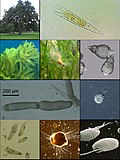The cryptomonads (or cryptophytes) are a group of algae, most of which have plastids. They are traditionally considered a division of algae among phycologists...
14 KB (1,398 words) - 00:24, 23 October 2024
Two unrelated types of ejectosomes are described in the literature: Cryptomonads have two types of characteristic extrusomes known as ejectosomes. Intracellular...
2 KB (217 words) - 21:20, 8 November 2023
List of sequenced algae genomes (section Cryptomonad)
This list of sequenced algal genomes contains algal species known to have publicly available complete genome sequences that have been assembled, annotated...
41 KB (2,087 words) - 01:49, 21 October 2024
bacteria, in particular, many pentatricopetide repeat proteins. The cryptomonad and chlorarachniophyte algae may contain a nucleomorph that resembles...
65 KB (7,284 words) - 08:11, 23 October 2024
megagroup". because it included plants (Archaeplastida), haptophytes, cryptomonads, and stramenopiles, alveolates, and rhizarians. Diaphoretickes has been...
8 KB (739 words) - 18:38, 1 November 2024
2003). "Genetic analysis of the psbA gene from single cells indicates a cryptomonad origin of the plastid in Dinophysis (Dinophyceae)". Phycologia. 42 (5):...
92 KB (10,574 words) - 09:31, 28 October 2024
Stramenopiles (Brown Algae, Diatoms, etc.), Haptophyta, Cryptophyta (or cryptomonads), and Alveolata Archaeplastida (or Primoplantae) Land plants, green...
74 KB (4,820 words) - 14:36, 24 October 2024
Guillardia is a genus of marine biflagellate cryptomonad algae with a plastid obtained through secondary endosymbiosis of a red alga. Originally identified...
28 KB (3,097 words) - 19:18, 25 May 2024
which are most closely related to genes encoded by the Guillardia theta (cryptomonad) nucleomorph genome. Four of these genes are also found in red algal...
148 KB (15,296 words) - 18:57, 2 November 2024
after the bioluminescent forms, or Dinophyta. At various times, the cryptomonads, ebriids, and ellobiopsids have been included here, but only the last...
96 KB (10,340 words) - 12:19, 2 November 2024
store their starch in the plastids, whereas red algae, glaucophytes, cryptomonads, dinoflagellates and the parasitic apicomplexa store a similar type of...
60 KB (6,385 words) - 13:09, 24 October 2024
eukaryote's nucleus are often transferred to the secondary host's nucleus. Cryptomonads and chlorarachniophytes retain the phagocytosed eukaryote's nucleus,...
189 KB (19,141 words) - 15:05, 28 October 2024
introns. In 1995 scientists discovered the first non-Euglena twintron in cryptomonad alga Pyrenomonas salina. In 2004, several twintrons were discovered in...
8 KB (1,121 words) - 12:37, 14 February 2023
classified in the supergroup Chromalveolata alongside haptophytes and cryptomonads, being believed to have acquired plastids through secondary endosymbiosis...
11 KB (1,083 words) - 14:24, 2 November 2024
known to contain plastids with a vestigial nucleus or nucleomorph: the cryptomonads of the supergroup Cryptista and the chlorarachniophytes of the supergroup...
11 KB (1,190 words) - 12:44, 17 April 2024
Cryptaulax (protist) (redirect from Cryptaulax (cryptomonad))
type of cryptomonad. Subsequent studies suggest that it is euglenozoan. Because Skuja had clearly misidentified the flagellate as a cryptomonad, Vørs argued...
3 KB (238 words) - 19:18, 25 May 2024
Cryptomonas is the name-giving genus of the Cryptomonads established by German biologist Christian Gottfried Ehrenberg in 1831. The algae are common in...
14 KB (1,553 words) - 19:18, 25 May 2024
Hemiarma marina (category Cryptomonads)
monotypic species of cryptomonad discovered off the coast of Palau in 2016. Shiratori; Ishida (2016), "A New Heterotrophic Cryptomonad: Hemiarma marina n...
914 bytes (46 words) - 11:34, 1 October 2024
heterotrophic flagellates known as katablepharids, as well as the abundant cryptomonads (=cryptophytes), which comprise the heterotrophic Goniomonadea and the...
4 KB (208 words) - 23:07, 11 August 2024
and yellow-green), dinoflagellates, euglenoids, coccolithophorids, cryptomonads, chrysophytes, chlorophytes, prasinophytes, and silicoflagellates. They...
304 KB (29,025 words) - 11:04, 2 November 2024
chloroplasts. Mesodinium rubrum is a ciliate that steals chloroplasts from the cryptomonad Geminigera cryophila. M. rubrum participates in additional endosymbiosis...
16 KB (1,589 words) - 08:07, 14 June 2024
organisms. Some Dinophysis spp. have kleptoplastids of cryptomonad origin, specifically from the cryptomonad Teleaulax amphioxeia. Dinophysis caudata have acquired...
24 KB (2,467 words) - 21:17, 10 May 2024
ingests flagellates including cryptomonads. The prey is ingested very rapidly into a food vacuole without the cryptomonad flagella being shed and the trichocysts...
5 KB (595 words) - 10:45, 1 February 2024
Hacrobia (redirect from Cryptomonads-haptophytes assemblage)
The cryptomonads-haptophytes assemblage is a proposed but disputed monophyletic grouping of unicellular eukaryotes that are not included in the SAR supergroup...
10 KB (897 words) - 10:13, 22 July 2024
Stramenopiles: brown algae, diatoms, water moulds, etc. Haptophytes Cryptomonads In 1994, Cavalier-Smith and colleagues indicated that the Chromista is...
26 KB (2,441 words) - 01:22, 10 October 2024
Goniomonadea (category Cryptomonads)
Goniomonadea is a proposed class of cryptomonads which includes the orders Goniomonadida and Hemiarmida. Order Goniomonadida Novarino & Lucas 1993 [Goniomonadales...
1 KB (81 words) - 17:24, 5 July 2024
cryptobiotic, cryptochrome, cryptogam, cryptogenic, cryptography, cryptology, cryptomonad, cryptophyte, cryptosystem, grot, grotesque, grotto cten- comb Greek...
42 KB (289 words) - 19:50, 4 October 2024
C. elegans most commonly refers to the model round worm Caenorhabditis elegans. It may also refer to any of the species below. They are listed, first in...
127 KB (13,031 words) - 02:11, 26 July 2024
yellow-green), diatoms, dinoflagellates, euglenoids, coccolithophorids, cryptomonads, chrysophytes, chlorophytes, prasinophytes, and silicoflagellates. Zooplankton...
42 KB (4,587 words) - 19:36, 20 October 2024
cryptobiotic, cryptochrome, cryptogam, cryptogenic, cryptography, cryptology, cryptomonad, cryptophyte, cryptosystem, grot, grotesque, grotto cten- comb Greek...
2 KB (1,500 words) - 19:52, 29 October 2024




















